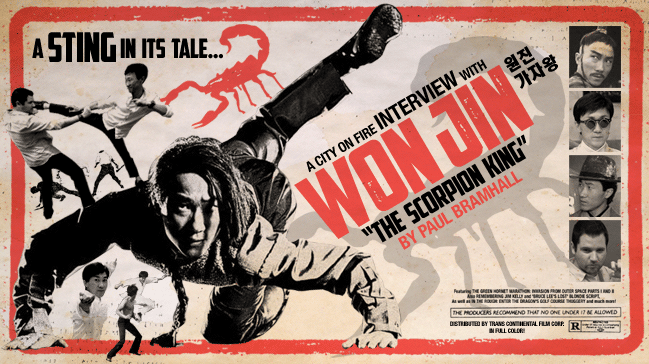
Back in 2002 I could still be considered a relative newcomer to the world of kung fu cinema, having gotten into the genre only a few years earlier. Living in the UK, most of my kung fu movie watching came in the form of picking up the latest release from the Hong Kong Legends label, which at the time was going through its own golden era. This particular year saw them release a title by the name of The Scorpion King, from 1992. It was a production which featured some familiar names, such as Chin Kar Lok and Lau Kar Leung, and some not so familiar, namely, a certain Korean gentleman called Won Jin.
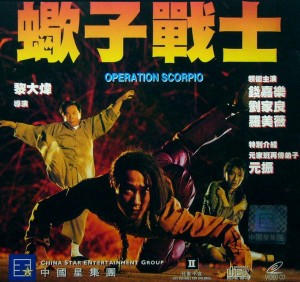
Keep your Blu-ray discs. It was all about “Operation Scorpio” on high definition VCD.
Essentially playing the villain of the piece, as Sunny the Scorpion, Won Jin marked himself as a legend of kung fu cinema in just a single movie. Showing amazing physical dexterity and flexibility, his kicks seemed to defy gravity, and in the image that defines him, he drops down onto one knee while propping himself up with both hands, arching his other leg over his back to perfectly imitate a scorpion. Not many people can claim to have made such a memorable impact on the genre so quickly, however after featuring in the trashy Women on the Run the following year, just like that he seemed he disappear from the Hong Kong movie scene.
Many rumors circulated around what exactly happened to the mysterious super kicker after so brightly lighting up the screen, from health issues to mentions of him possibly having died. Thankfully the later wasn’t true, however apart from briefly returning to Hong Kong cinema in the early 2000’s, Won Jin has mostly remained behind the camera in his native Korea. Then, seemingly out of the blue, in 2013 he appeared back on the screen in the Korean action movie The Suspect. Despite only being onscreen for a few minutes, they weren’t wasted, as he faced off against the title character in a scene which showed he still very much had all the moves.
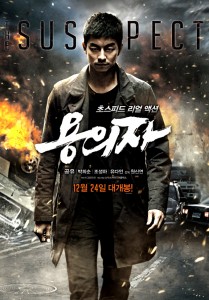
“The Suspect” Korean Theatrical Poster
His appearance in The Suspect was followed by a more substantial role in the 2015 production Kwon Bob: Chinatown, in which he plays the leader of a villainous Chinese gang. Despite its clear low budget, whenever Won Jin is onscreen he lights it up just as he did almost 25 years ago, displaying an array of kicks that the Scorpion King would be proud of.
As it happened, I planned to visit Seoul, the capital of Korea, in September 2015, and in one of those rare light bulb moments, the thought crossed my mind – I’m in Korea, Won Jin has a new movie out, why don’t I try to contact him for an interview? That’s exactly what I did, and after several e-mail exchanges, on the afternoon of 25th September I was greeted by Sunny the Scorpion in a quiet café, located within the backstreets of Gangnam. What was supposed to be just an hour long interview, surprisingly turned into us spending the next 12 hours together, encompassing coffee, alcohol, live octopus, and karaoke.
Below is the transcript of our conversation, which covered everything from his beginnings in the Korean movie industry, to his time in Hong Kong, to his present day activities working in both Korea and China. I hope you enjoy it.
Note: The interview was conducted using a mix of English and Korean.
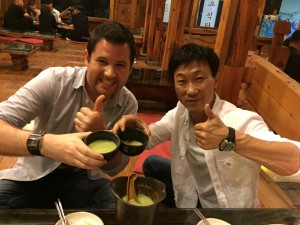
Author Paul Bramhall and Won Jin kicking back with a cup of pine tree dongdongju.
PAUL BRAMHALL: Master Won Jin, first of all thank you for taking the time out to meet for an interview. I wanted to start by asking about the 2013 movie The Suspect. Of course many of your fans know you from your Hong Kong movies, and some also know of your early Korean productions, but The Suspect marked your return to the screen after a particularly long absence. How did you come to be involved in this movie?
WON JIN: You’re welcome! Well with this movie, actually my work in Korea has mostly been action directing, and I was also involved in constructing some of the action scenes for The Suspect. However director Won Sin-yeon, he knew of my earlier work and was some what of a fan, so he told me that he’d developed a small role in the movie which was just for me, and hoped I would take it. It’s true that I haven’t been in front of the camera for a long time, but of course, it was quite special to have a role made just for myself, so I said yes. I had to train the lead actor, Gong Yoo, how to perform the fight choreography, and I put together the fight scene myself. Gong Yoo learnt quickly, so we were able to film the scene to a high level. When did you see that movie? Was it in England?
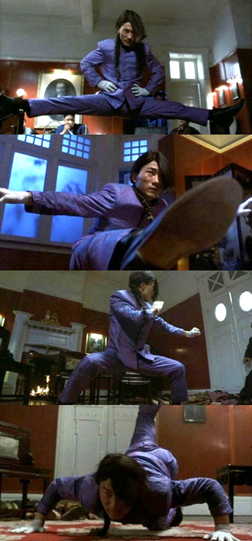
Won Jin’s now famous “scorpion” pose.
PB: I watched it a couple of years ago upon its release, but not in England, in Australia.
WJ: Ah, it’s good to hear that you watched it. I took a long break from appearing in front of the camera, because many action movies these days, any actors can play the part in them. But for me, I like the martial arts! So with the chance to perform a fight and assist with the fight choreography in The Suspect, we hoped it would be popular internationally and not only in Korea. Even though Hong Kong doesn’t make martial arts movies to the level it used to, it still has a market for them and they can be popular. In Korea that’s not the case, so we hoped with The Suspect the action would be popular in Korea as well as internationally, particularly in China, the Chinese market still appreciates martial arts in movies.
PB: And now of course you have quite a substantial action role, as the Chinese gang boss in the new movie Kwon Bob: Chinatown. When I watched this I was surprised to see you still seem to move just as well as you did over 20 years ago. What made you decide to take the part?
WJ: (laughter) You know I exercise every day, so staying healthy is very important for me! With Kwon Bob: Chinatown, we actually filmed this movie over just 15 days in 2014. It’s a very low budget movie, I would almost say it’s a no budget movie (laughter). However these days I’m getting older, so I have a lot of ‘little brothers’ working in the industry, especially who want to get into action. Many of my ‘little brothers’ were involved in this production, and they asked me if I’d take the part. To help them out, I said yes, and also with it being an action role, I thought it would be a nice fan service for those who wanted to see me onscreen again. I choreographed all of the fights myself, and despite the low budget, I thought I can still make the action exciting with my choreography and kicks. It also gave me the opportunity to train my ‘little brothers’, and give some advice on how best to make a martial arts movie and film the action scenes. But it’s very much the opposite of The Suspect, please don’t watch the movie thinking it’s a big budget production, it was a very quick film, but I hope you enjoyed my performance in it.
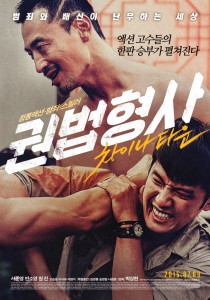
“Kwon Bob: Chinatown” Korean Theatrical Poster
PB: I did, and I’m sure your other fans will too once it gets a wider release. I noticed your character only speaks Mandarin in the movie, and as you mentioned you hoped The Suspect would break the Chinese market, was the decision to have your character speak in Mandarin also to help it break the Chinese market?
WJ: (laughter) No, if it breaks the Chinese market, I would be surprised! It was just the way the character was developed. You know every day I would just memorise the sounds of my lines, I really had no idea what I was saying, just practice pronouncing these lines correctly, say them, then fight. You know the last fight scene?
PB: The one in the restaurant?
WJ: Yes, that one, it took 7 hours to complete. I choreographed the whole thing, and it was such a tight filming schedule, so it was a tiring experience! (laughter)
PB: Wow, and there’s also the scene in the parking lot were you take on multiple opponents, how long did that one take?
WJ: Ah, that one, that took 8 hours! It’s impossible! Thinking now I don’t know how I did it, I don’t want to repeat that experience again, but I hope my fans can appreciate the hard work.
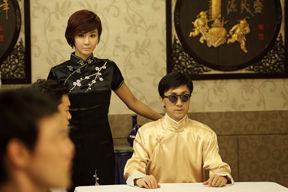
Won Jin in a still from “Kwon Bob: Chinatown”
PB: Now going back to when you first got into the movie industry, the Korean Movie Database has your first movie as The Undertaker of Solhwa Province in 1983. Could you tell us a little about how you got into the film industry?
WJ: Actually that listing is not completely correct. My debut was in a 1979 movie called The Eighteen Amazones (aka Bruce Lee’s Ways of Kung Fu). I was just a stuntman in the movie, and the two mains stars were Dragon Lee, he was kind of a Korean version of Bruce Lee, and Chang Il-do, do you know these actors?
PB: Yes, I know their movies very well, Chang Il-do (aka Bruce Lai) also did some Bruce Lee-like movies.
WJ: Yes he did, sadly Chang Il-do passed away last year, but he became my manager for a couple of years in the early days. In the movie I was doing doubling for women, they would stuff my top with padding so it looked like I had breasts, then the more acrobatic moves would be performed by me. I was just 19 at the time, but that was my first taste of working in the movie industry. Like most people my age, the Bruce Lee movies were hugely popular when I was a child, and I’d watch his movies and think I also wanted to be like him.
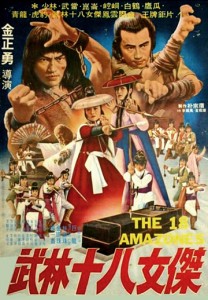
Won Jin’s movie debut, “The 18 Amazones” (aka “Bruce Lee’s Ways of Kung Fu”)
My father was also a martial artist, now many people tell me I look like my father, I think so too. I have memories of him and how he’d break rocks with his bare fists, he had a lot of power. Sadly when I was 19 he passed away, but that gave me more determination to break into the film industry, I had to prove my worth and I was determined to do it. So The Eighteen Amazones is the movie that gave me that first opportunity.
PB: And what was it like working in the Korean movie industry at that time? I imagine it would be a different world to the industry today.
WJ: A year before The Eighteen Amazones there had been a Hong Kong movie, Drunken Master with Jackie Chan. At that time everyone in Korea went crazy for kung fu, we all wanted to copy the Drunken Master style, so there were many Korean kung fu movies which imitated that style. For someone that wanted to get into martial arts movies, there weren’t too many avenues available in Korea to do something different, however I didn’t want to spend my whole career just as a stuntman. Hong Kong was making so many kung fu movies, and Jackie Chan was going against other Koreans like Hwang Jang-lee and Wang In-sik, so it made me more determined to act in a kung fu movie, but it was quite difficult.
PB: I see, and was it your father that originally introduced you to the martial arts?
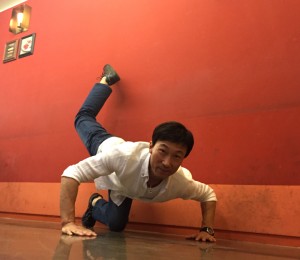
Won Jin recreates his famous pose, Gangnam Style!
WJ: Yes, actually when I was a child my father thought my demeanour was a little girlish, so when I was 7 he made me start practicing Taekwondo, and of course I was watching the Bruce Lee movies. Because of them, I became really obsessed with nunchucks (laughter). But because of Bruce Lee, I became interested in movie fighting, so when I was 8 me and my friends would practice fighting with each other like in a movie. The more I learnt about Bruce Lee, I read that he made his own martial arts, so I decided that with my Taekwondo training, I would make my own style, the Won Jin style! (laughter) So I would practice doing different kinds of kicks and kicking combinations, mixing in some flips and things like this, and I would imagine what they would look like in a movie.
PB: Great, and apart from the training you received in Taekwondo, did you study any other martial arts?
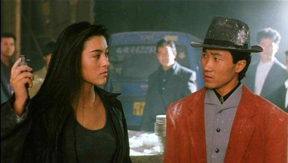
Won Jin in a scene from “Women on the Run”
WJ: After I studied Taekwondo very hard, I really put all my efforts into focusing on creating my own style. So I started to think of what kicks I can create and how they could be incorporated into action scenes, this is how the progression of my martial arts training developed, I had a real passion for creating my own distinctive style. Despite this though, I was still very young, and teaching myself was very hard. If I had a teacher, you know someone like Jackie Chan or Bruce Lee, who could have shown me how to fight in a way that looked great onscreen, it would have been much easier! (laughter) But I was driven, so I persisted to keep on practicing and learning by myself.
PB: Speaking of your own style, now would be a good time to bring up a question I wanted to ask you. I know you choreographed the 2001 movie My Wife is a Gangster, but did you do some doubling for the lead actress Sin Eun-kyeong? Especially the fight in the rain at the start, some of those kicks looked very familiar!

Won Jin signs his life away.
WJ: Yes, I did! I had to double for a woman again, you know it’s the second time! But yes, for some of the more complicated kicks, it’s me. It’s funny, you know, Sin Eun-kyeong actually has a fuller body than me, so I felt like I had to act more tough when I was doubling for her! When she was in character, I felt my demeanour was girly again (laughter). I’m glad you recognized my kicks, I can say all the hard work from when I was a child paid off! By the way, do you know Mike Leeder?
PB: Yes, I know him, we sometimes talk on occasion.
WJ: Oh! Well, I met Mike Leeder maybe that same year that My Wife is a Gangster came out, around that time. He’s also from England like you, and he came to Korea, similar to what we’re doing now. I made a new showreel with him, and he published an article about me, he’s a good guy. I thought if you like action then it’s possible that you know him! (laughter)
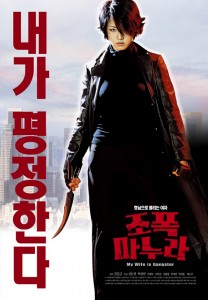
Won Jin choreographed the fight scenes for the 2001 Korean hit “My Wife is a Gangster”
PB: Right, he’s a familiar face in the Hong Kong movie industry, and of course I think the showreel you’re referring to was included as an extra on the UK DVD for Scorpion King. This is without a doubt the movie you’re most famous for, as the character Sunny the Scorpion, can you tell us how you came to work in the Hong Kong movie industry?
WJ: It was back in 1991 that I first went to Hong Kong, however my journey to get there started a year earlier in 1990. At that time there was a movie agency situated in Hong Kong, it kind of specialised in action movies, and this agency put out an ad internationally requesting for martial artists to submit showreels of themselves, potentially to be cast in martial arts movies. After I saw the ad, I filmed a video of me demonstrating all of the kicks and moves that I’d created and been practicing.
After I submitted this showreel, a few Hong Kong directors who saw it actually came to Korea to visit me. They were really interested in some of the kicks I’d displayed in my showreel, so they asked if I could train them a little on the types of techniques I use, which I did. One of the directors who visited me was David Lai, and as it turned out we got along really well. Director Lai eventually invited me to Hong Kong, and we made 3 movies together there. On Saviour of the Soul 2 I just had a very small role, so that he could see if I could work well in a Hong Kong movie, then after that we made The Scorpion King and Women on the Run together.
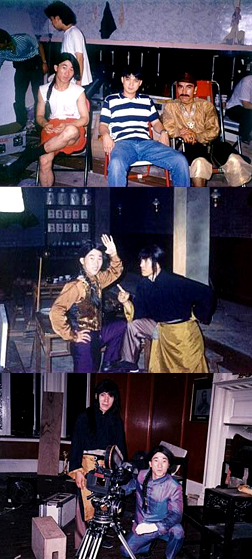
Rare behind-the-scenes photos from “The Scorpion King”
PB: Of course in Hong Kong movies at the time, the action choreographer was a very important role. In The Scorpion King, you didn’t just get to work with one action choreographer, but 3 of the very best in Lau Kar Leung, Corey Yuen, and Yuen Tak. What was it like to work with such talented martial arts directors?
WJ: Working with these three, I can say that they were truly A class. Their direction and vision was so ambitious, and it was an exciting time to be working with them. Lau Kar Leung in particular, at that time he was a similar age to what I am now, but I remember clearly he had so much energy and power. Back then, he was living with a woman who was 25 years younger than him, really so much energy! (laughter) When we had our fight, you could really feel that energy and power, I was very surprised because he was so much older then me! But I felt that we were a good match when we were fighting, and I could feel that it was going to be a good scene. Another memory I have of Lau Kar Leung is his coffee intake, he would drink maybe 10 cups of coffee per day when we were working on the film, he could never get tired of coffee! His nickname was ‘Sifu’, and on set that’s what everyone called him, and I learnt why very quickly. You know he passed away now?
PB: Yes, it was a couple of years ago.
WJ: Right, it’s a great loss to the martial arts world. You know the following year after making The Scorpion King, Lau Kar Leung called me, and he wanted me to come to America with him to help work on the movie Teenage Mutant Ninja Turtle III, so I was really excited. But, I couldn’t get the working visa for America, so our chance to work together again was cancelled! So sad.
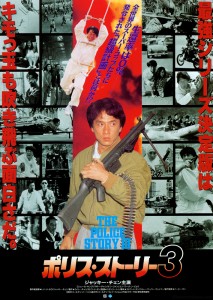
Due to scheudling conflicts, Won Jin had to turn down Jackie Chan’s offer to appear in “Police Story 3”
PB: I had no idea about that, what a missed opportunity!
WJ: It was. There were a couple of missed opportunities while I was in Hong Kong. You know Jackie Chan called me, as he’d seen me in The Scorpion King, and he asked me if I could play a character in Police Story 3 and we would have a fight together. It was an exciting opportunity, however I was loyal to director Lai, and I’d already committed to take a role in Women on the Run which was filming at the same time, so I had to turn it down. The funny thing is, a couple of days before Jackie called me, I’d actually had a dream about fighting him, so to receive his phone call so soon after, it was like some sort of destiny!
There was also a Jet Li movie, I don’t remember the name, but Corey Yuen was working on it, and we’d worked together on The Scorpion King, so he asked me if I could take a role against Li. But unfortunately at that time as well I was also busy, so the chance was cancelled. A shame!
PB: Ok now you’re depressing me. (laughter) Going back to The Scorpion King, the choreography is very Hong Kong style, but watching you in action, your moves are clearly Won Jin style. Was there any difficulty in integrating your style of action into the choreography that Lau Kar Leung, Corey Yuen, and Yuen Tak had in mind?
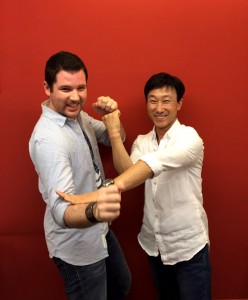
Paul and Won Jin goofin’ around between conversations.
WJ: Right, thankfully the choreographers were very talented to incorporate my moves into the fight scenes. The way the fight scenes developed was that Lau Kar Leung, Corey Yuen, and Yuen Tak were given a copy of my showreel, which I’d made in Korea, by David Lai. It was lucky because I really put my all into that showreel, so it showed off the whole array of my moves and what I’m capable of doing, then based on what they saw, they then incorporated those moves into the fight scenes. As you can see in the movie, in every one of my fight scenes I just use my kicks, almost no hands, and that reflects what they saw in the showreel.
PB: And for the famous scorpion pose itself, was this an idea of director Lai, the action directors, or yours?
WJ: That was always director Lai’s idea to have this kind of pose for the character, however the problem was to find someone who could do it, so I was happy to be able to deliver the vision that he had. You know an acquaintance contacted me sometime after the movie was released, and he told me that during the monk’s performances from Shaolin Temple, the scorpion pose had now been included in it! It’s crazy. The pose has appeared in other places as well, there’s a Korean pop music group, they’re called Infinite, they do it in one of their music videos (‘Before the Dawn’). And BYC, a clothing manufacturer here in Korea, they released a range of clothing called the Scorpion Collection, and all of the advertising images for the range have the models performing the pose as well! (laughter)
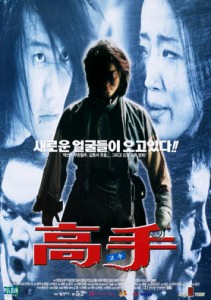
“High Grade Player” Korean Theatrical Poster
PB: It’s interesting to hear what an influence it’s had on popular culture.
WJ: Yes, and you know David Lai, he had the idea for The Scorpion King 2, and I was going to come back as Sunny. However it was never able to get off the ground, some financing issues, and a couple of years later director Lai wasn’t as active anymore, so finally the idea was cancelled. But even though it didn’t happen as a Hong Kong movie, actually I’d still like to make The Scorpion King 2, maybe here in Korea, maybe in China. I’m confident I could still give a good performance, but with filmmaking, the issue is always to get financing, so you know it’s hard. But one day, I hope it’ll happen.
PB: I’m sure there are plenty of your fans out there who are hoping it will happen too. The funny thing about Sunny is of course that he’s the villain of the piece, but he became much more iconic than the characters played by Chin Kar Lok and Lau Kar Leung, who are the good guys!
WJ: (laughter) Actually Sunny isn’t the bad guy, his father is the bad guy. Sunny just does what his father tells him to do and wants to protect his family, so I’d say that rather than calling him a bad guy, he should be called a good son!
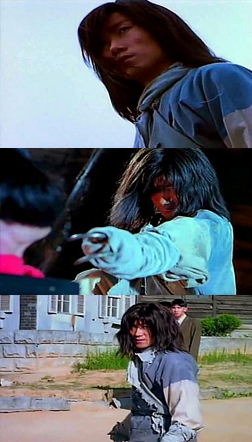
Scenes from “High Grade Player”
PB: You know I’d never looked at it that way until now! Now after you completed Hero from Beyond the Boundary of Time in 1993, you seemed to disappear from the Hong Kong movie scene, and didn’t re-appear until 2000. Can you tell us about what you were doing during those 7 years?
WJ: Right, in 1994 I returned back to live in Korea from Hong Kong. But actually that time was a little stressful, when I left Korea, the action movie genre was still quite popular here. But even just a few years later, when I came back the Korean action movie had kind of disappeared, and it seemed that TV drama had become really popular. So after taking a rest, I became quite anxious about what I was going to do back in Korea.
PB: I’m not sure if you’re aware, but there were many rumors about what had happened to you at the time, from health problems, to one of them even being that you’d died. Was there any truth in any of these?
WJ: Yes, I heard some of those rumors, one that I read had mentioned I’d lost both of my legs! (laughter) There is some truth in me having health issues at that time, I have a sensitive stomach, and compared to Korean food, I found Hong Kong food to be so greasy. What the exact reason was, I’m not sure, but I developed a liver problem and was hospitalised for a few days. After that though I was fine, and I was really thankful to be able to enjoy Korean food again in Korea. I guess you could say the sickness that I was suffering from was a kind of home sickness, so I was happy to be back in Korea again.
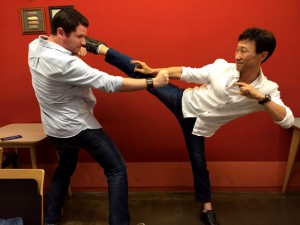
Miraculously, Paul walked away unharmed.
PB: 3 years after you’d returned to Korea, you took on one of the main roles in Kim Chun-sik’s movie, High Grade Player, in 1997. It was great to see you back in a role doing martial arts again, how did you come to be involved?
WJ: Kim Chun-sik was from the same era of Korean martial arts movies that I started off in, like me he was a stuntman, and we’d sometimes worked together. Since then he’d developed into a director. He called me one day and said he was going to direct High Grade Player, and said that he’d like for me to take this particular role. After discussing the movie with him, I felt confident that I could perform well playing this type of character, so my heart was telling me that I should take it. You know the character, even before production started on the movie, I felt that he was kind of in the same style as The Scorpion King. He has the unique traits, like a hook for a hand and the long hair, and he’s deadly with his kicks, so in some ways it kind of felt the character was related to Sunny the Scorpion. (laughter)
PB: And how did it feel for you to be back doing a martial arts movie in Korea, now that you’d had the experience of working in Hong Kong?
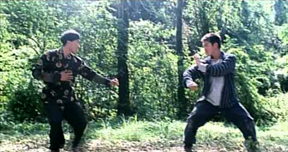
Won Jin faces off against Yuen Biao in a still from “No Problem 2”
WJ: Firstly, director Kim had a lot of experience in the industry, from being an action star in the past in front of the camera, to his experience working behind the camera as well. Because of that, working with him and taking his direction was very easy, there were no difficulties at all. In Hong Kong, I wouldn’t say it was a problem, but because of the language barrier often scenes would be explained with body language, or choreographers would play out the fight to show what they wanted. Normally my scenes in Hong Kong only took a few days to shoot, so it was never considered worth it to hire a translator. This worked well, but still it was nice to be in Korea and be able to talk to the director. By that time of course director Kim had seen my Hong Kong movies, so he let me have a lot of control over my action scenes and give input on the choreography.

Won Jin with Kang Kyong-joon and Chen Jia Jia.
As for the differences between the two industries, there are so many. What would be considered to be a mid-budget production in Hong Kong, would be considered big budget in Korea at that time, so High Grade Player didn’t have much money behind it which was a shame. The cultures as well of course are completely different, but specifically talking about the culture of making action movies, in Hong Kong they could spend days choreographing and filming just a single fight scene. In Korea it was very different, the fight scenes had to be put together and filmed much quicker, and I think that was partly because we didn’t know if there would even be an audience for the movie. In Hong Kong, it was guaranteed many people would go to see the martial arts movie, so martial arts stars were popular and expectations were high from their performances. I felt envious that Korea didn’t have the same attitude towards martial arts movies, however Hong Kong can be considered as the birthplace of the martial arts movie, and their industry had developed over many years to become what it was. In 1997 Korea didn’t have that yet, so it was much harder.
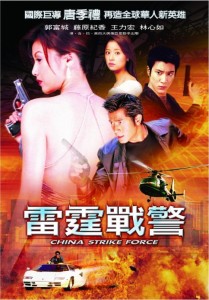
“China Strike Force” Hong Kong Theatrical Poster
PB: Speaking of Hong Kong movies, in the last scene of High Grade Player, when you take on a small army single handedly, I noticed it’s filmed using the ‘step printing’ technique. Sammo Hung had used the same technique in a fight scene for the Jackie Chan movie Thunderbolt, a couple of years earlier. Was that scene inspired by the scene in Thunderbolt in any way?
WJ: Oh, in that last scene, actually I’d choreographed the scene but didn’t know it was going to be filmed in such a way. The decision to film it that way was an idea of one of the production staff, who believed it was a good way to visually show the rage of the character, having witnessed the person who killed his mother die. Personally I don’t think it shows off my action in the best way, and I know many martial arts fans would maybe be expecting a differently filmed scene, but in the end it was done that way to show the emotional trauma of the character.
PB: Now in 2000, just as quickly as you disappeared from Hong Kong movies, you re-appeared with a role in China Strike Force. What led to you returning briefly to the Hong Kong film industry?
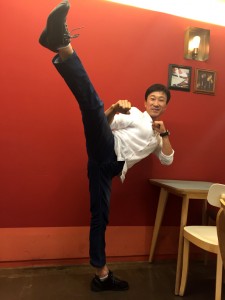
Kickin’ it with Won Jin.
WJ: Oh, this came about because I had a friend in Hong Kong. My friend was also friends with Stanley Tong, and when he announced he was going to be making this movie, my friend recommended me to director Tong for a role. Of course I’d missed the opportunity to work with director Tong on Police Story 3, and I’d heard that this new movie was also going to feature Ken Lo from Drunken Master 2, so it sounded like a good opportunity. But actually, the movie turned out to be no good, it had a big budget, but the quality wasn’t there. When I learnt about my role for the movie, I felt like it didn’t play to any of my strengths, so I don’t really know why director Tong thought it would be a good idea to have me involved. Then my death scene, oh, you know I don’t really want to remember this movie, can we just forget about it? (laughter)
PB: Sure, forgotten! But you did stick around though, making No Problem 2 a couple of years later in what would be your final Hong Kong movie. This movie was directed by your co-star from The Scorpion King, Chin Kar Lok, was it good to meet him again?
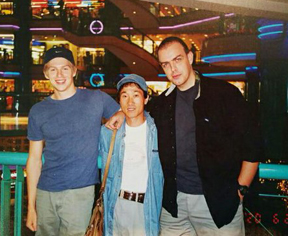
Reuben Langdon, Won Jin and Big Mike Leeder.
WJ: Oh ok! Actually this movie is a really good memory for me. You know me and Chin Kar Lok, after being in The Scorpion King together, we became good friends. So at the time of No Problem 2, we’d stayed in touch for 10 years, then he called me and said he was going to be directing a movie, with Yuen Biao, and he wanted me to be in it! It was really exciting, I was a fan of Yuen Biao, and Kar Lok told me Biao enjoyed my movies, so working on the movie was a really good experience.
We filmed for 7 days, and when I met Yuen Biao for the first time, he had such a great personality, he’s a really fun guy. At that time, Biao had put on a little bit of weight, but when it came to our fight, it turned out that we were a really good match, and he performed well. You know in Korea, we don’t have that many martial arts actors, so it’s really impossible to find someone who you’re a good match with and can work well together onscreen. But in Hong Kong, at that time, it was always great to find someone who you could be a good match with when performing martial arts. Now in Hong Kong, Chin Kar Lok became the chairman for the Hong Kong Stuntman Association, and sometimes he will call me from his office, inviting me to come there. Even now we’re still good friends. And you know we were discussing My Wife is a Gangster earlier?
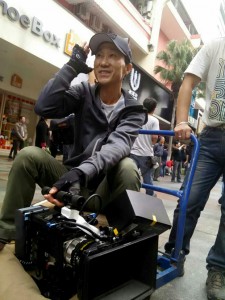
Won Jin busy working on his next project in China.
PB: Yes…
WJ: Well No Problem 2 filmed in 2001, and so did My Wife is a Gangster, so my time that year was split between filming No Problem 2 overseas, and working on the action choreography for My Wife is a Gangster in Korea, it was a busy year!
PB: It certainly sounds like one! Now with all of the action performances you’ve been involved in, both in Hong Kong and here in Korea, have you ever sustained any injuries?
WJ: Actually not really, of course when you’re doing action scenes, you’re always going to get cuts and bruises, however in terms of any major injuries, no never. Chin Kar Lok on the other hand, you know he doubled many times for Jackie Chan?
PB: Yes I’d heard that before.
WJ: Yes, I’m sure he suffered many more injuries than me, even we both have done doubling work, stuntwork is much more dangerous.
PB: Now that you mentioned Jackie Chan, you did pop up for a brief cameo in the 2006 Korean movie Almost Love, which opens with a fantasy sequence that has you playing Jackie Chan’s father when he’s born. How did that role come about?
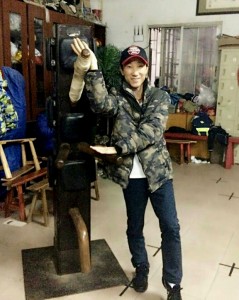
Won Jin poses with a dummy.
WJ: (laughter) I’m surprised you know about this! Actually this story is a little similar to how I got the role in The Suspect. I was doing the action choreography for the film, and the director of Almost Love, Lee Han, is also a fan of Hong Kong action movies, especially mine! (laughter) So he told me he had the idea for the scene, and he really wanted me to play the part, so of course I agreed to it, even though it’s just a brief role.
PB: One of the questions I was really looking forward to asking you is, out of all of the fights that you’ve been a part of in your movies, which is your personal favorite one?
WJ: I have to say going against Chin Kar Lok in the finale of The Scorpion King. You know it was a very special movie, nobody has ever forgotten that movie, so it’s very close to me. After it, I’d go out onto the street, and people would recognize me as Sunny the Scorpion, sometimes it happens even now, so I’m really glad to have been a part of it. I made a good friend with Chin Kar Lok, and we had a great fight onscreen together, so I’ll say it was my fight with him.
PB: Another old school martial arts star was a fellow Korean, Hwang Jang Lee. Now when The Scorpion King was first released, many people said you’re the next Hwang Jang Lee. How do you feel about this comparison?
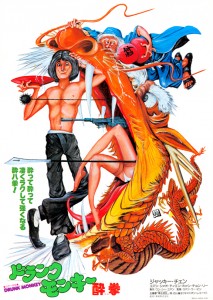
“Drunken Master” Japanese Theatrical Poster
WJ: Ah yes, I know Hwang Jang Lee, he’s actually in Seoul at the moment. I enjoyed his films from a long time ago, and of course the film which was so popular in Korea, Drunken Master, had Jackie Chan fighting him, so it’s a nice comparison. These days Master Hwang is much older, I believe he’s in his 70s now, but he still occasionally goes overseas to attend Taekwondo seminars and teach his techniques.
PB: Right, I’d also heard this. Since you’ve now been in the action movie industry yourself over 35 years, what’s your own personal preference, do you like acting and fighting onscreen, or creating the action choreography behind the scenes?
WJ: You know I like to do both. When you’re acting and performing in a fight scene, you have to really focus on the outlook, like how is my expression going to look onscreen, however with action directing, it’s very different, the process is internal and you have to think carefully. Actually action directing always makes me a little nervous, but it’s an excited kind of nervous. It can feel like a burden, because with each new production I put a pressure on myself to show some new technique and make the action seem new and fresh. However despite this, I still feel confident that I’m able to do it, so I enjoy each new challenge.
PB: That’s great, and now you’ve been working back in Korea as an action director since 2002, what for you has been your career highlight since then?
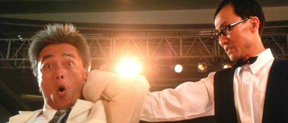
Won Jin in “China Strike Force”
WJ: Hmm, I worked on a couple of big movies shortly after returning to Korea from filming No Problem 2, and these movies still stick in my memory as being really enjoyable and challenging to work on. One was the sequel to My Wife is a Gangster, and for this one we tried to improve the action sequences from the original, so it was a big challenge to work on. The other is a movie called, do you know Sword in the Moon?
PB: Yes I know the movie.
WJ: I also was the action director for this movie, and it was really big budget, so it was a great opportunity to direct the action on such a big movie. Choi Min-soo comes with the reputation of being difficult to work with*, however when I had to work on a scene with him he was surprisingly quiet. When he was with me he was very respectful, and called me ‘Sifu’.
PB: And outside of your own work, do you have a favorite kung fu movie that you’ll watch when you have some free time?
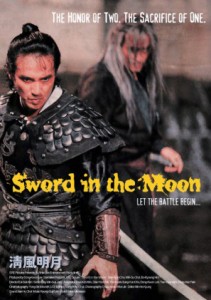
“Sword in the Moon” Theatrical Poster
WJ: Of course Bruce Lee, but more recently, I like to watch anything which features Donnie Yen. He’s really become popular in China these days and a big star, so it’s great to see a martial arts star become so popular. Even though we started working in the action movie industry in the same era, Donnie Yen’s choreography has become really great in recent years, it’s very realistic. It would be great if there was a chance to work with him, and have a fight against each other. Actually we were both working in Hong Kong at the same time, but I feel that especially now, both with the way his choreography has developed to the standard it is today, and my own, we could make a really good movie.
Also Ong Bak with Tony Jaa, this is a good movie. But only the first one! (laughter) You know Tony Jaa copies some of my moves in that film? (laughter)
PB: I’m sure he must be a fan of The Scorpion King! And my final question for you is, what can we expect next from Won Jin?
WJ: Right now I’m working on the action for The Suspect 2, and who knows, maybe I can get a scene in the sequel as well. (laughter) I’m also working on the action for a Korean TV drama, but right now I’m not allowed to give any details about that, it’s still top secret. (laughter) The drama will be screened at the beginning of next year. Actually though, I’m not really a fan of drama series, I like martial arts movies! On the drama series you’re never given much time to put together the action sequence and film it, everything happens very fast, so film is better for me.
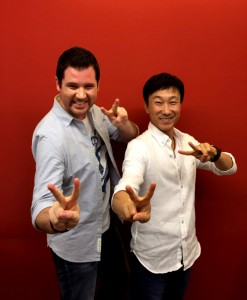
Peace out!
I also recently finished doing the action for a film in China, it hasn’t been released yet, and doesn’t have an English name, but translated directly, it would be Search for the Lost Heroic Grandmaster. The main star is the Korean actor Kang Kyong-joon, and the lead actress in Chen Jia Jia. Maybe you know her? She was in a couple of Donnie Yen’s movies, Seven Swords and Legend of the Fist: The Return of Chen Zhen. We shot the movie in Beijing, as these days there are more and more work opportunities there. It seems martial arts action is still popular in China, so I recently opened my own company there, it’s like an action consultancy agency, so I can help those who want to get into action and teach them, as well as be available for opportunities myself. We’ll see how it goes.
For now though, I’ll continue to work both in Korea and overseas!
PB: Master Won Jin, thank you very much for your time!
Special thanks to Seulki Choi for assisting to arrange the interview, and Ju-yeon Yu for acting as a translator.
* Director Kim Sung-ho also discussed Choi Min-soo in this interview.


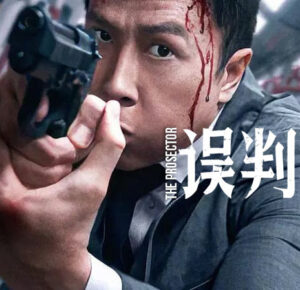

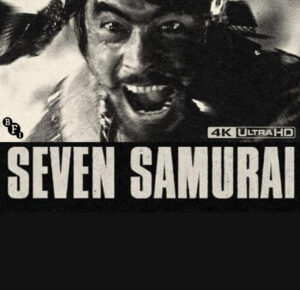
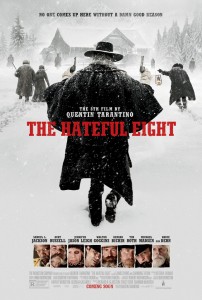

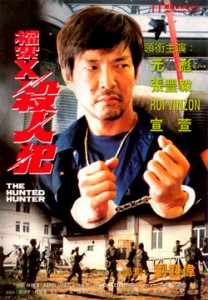
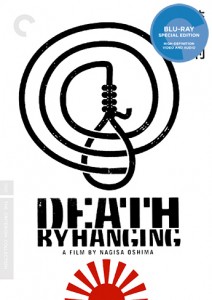
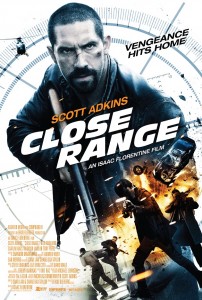
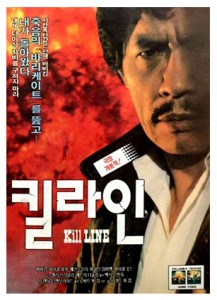
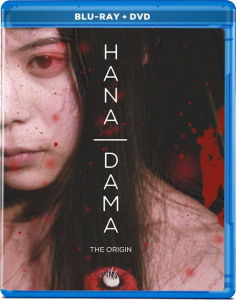





























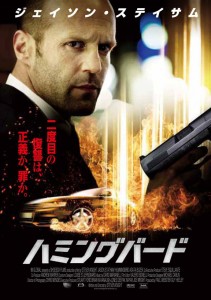
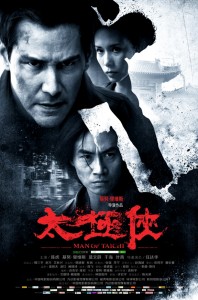
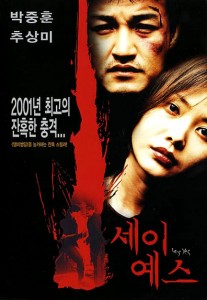


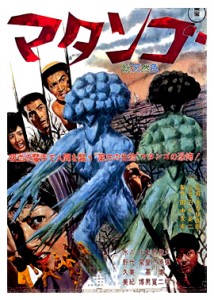



2 Comments